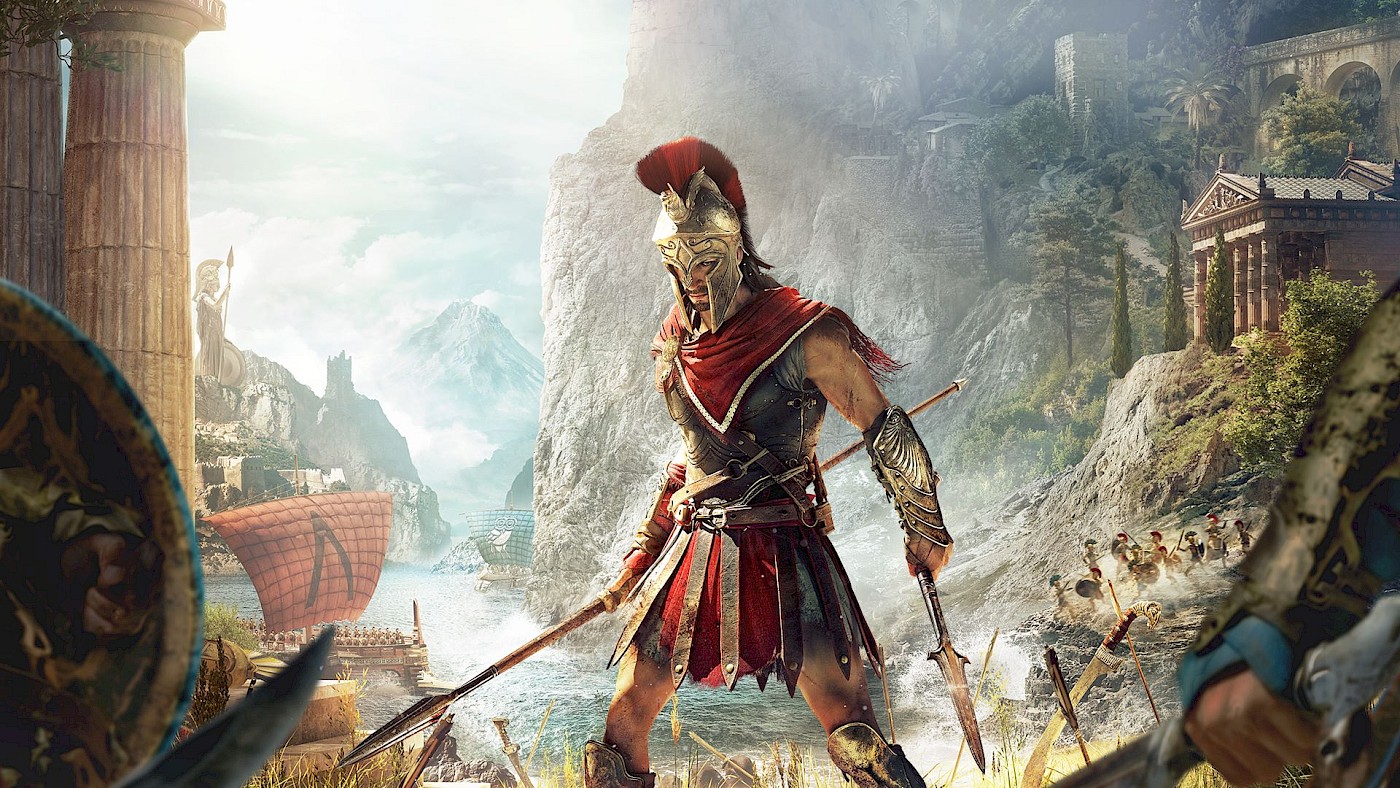Last time, we explored Cephalonia and killed the Cyclops (a bandit leader) to rescue a man called Barnabas. Barnabas has a ship we can use in order to fulfill a mission for Elpenor. This rather dodgy character has tasked us with killing a Spartan general nicknamed “The Wolf”.
Killing babies
When Cassandra gets aboard Barnabas’ ship and tells him of their mission, he asks her who would want Nikolaos of Sparta dead. “Nikolaos of Sparta?” Cassandra asks. She’s visible taken aback: Nikolaos of Sparta is her father.
We’re then shown a flashback. The scene is set in Sparta, during a dark and stormy night (I’m not kidding). We see Nikolaos and his wife Myrinne, as well as the young Cassandra. A baby is held up by an older man, who claims that “the oracle has spoken”, and that the child has to die.
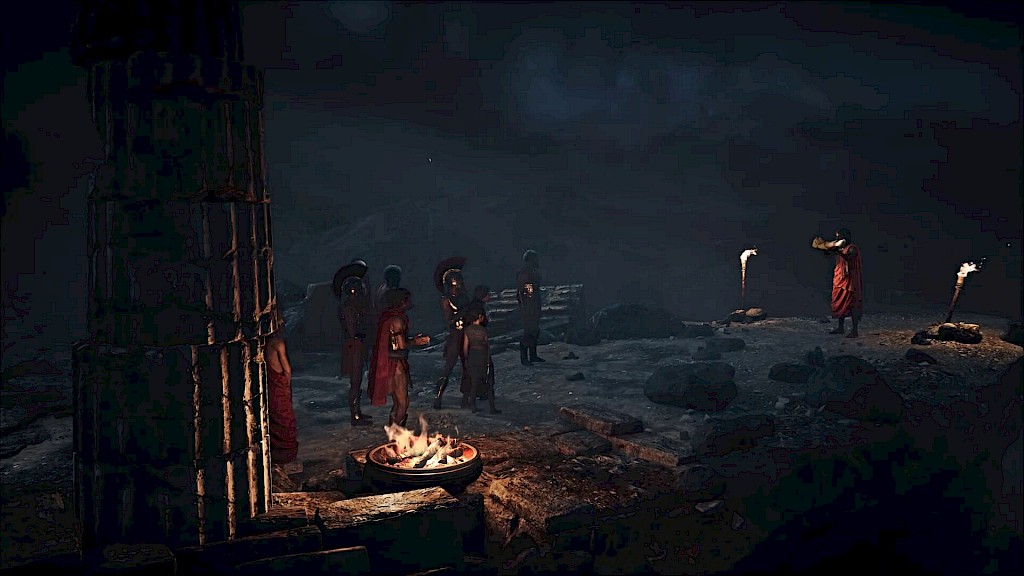
Myrinne is distraught as the man carries the baby to the cliff’s edge. Cassandra rushes towards the man and accidentally pushes him off the edge; the baby falls, as well. A “civilian” (as the subtitles refer to him) calls out: “Murdered! She has killed him!” Another yells that they have to throw Cassandra over the cliff, too. Myrinne pleads with Nikolaos, who walks over to Cassandra, grabs her by the arm and, after a moment’s hesitation, lets her fall.
This scene is (very loosely) based on a single passage in Plutarch’s Life of Lycurgus (16):
Offspring was not reared at the will of the father, but was taken and carried by him to a place called Lesche, where the elders of the tribes officially examined the infant, and if it was well-built and sturdy, they ordered the father to rear it, and assigned it one of the nine thousand lots of land; but if it was ill-born and deformed, they sent it to the so‑called Apothetae, a chasm-like place at the foot of Mount Taygetus, in the conviction that the life of that which nature had not well equipped at the very beginning for health and strength, was of no advantage either to itself or the state.
There are some important points to make here. First of all, Plutarch doesn’t say that unwanted babies were cast off the mountain, like you see in the game, but instead that they are sent to Apothetae. That literally means “the throw-off place”, but it seems unlikely that babies were actually hurled from a cliff here: more likely, it’s the place where children were abandoned (cast off), rather than murdered. Unwanted children would be left there to die of exposure, similar to what happened with unwanted children known from various stories (e.g. Oedipus, Paris). (My thanks to Roel Konijnendijk for his comments about this passage from Plutarch.)
Why would the ancient Greeks not simply kill an unwanted child? According to their beliefs, murder would inflict miasma or religious pollution on the murderer. Directly killing an infant was therefore out of the question, but leaving a baby somewhere to die of exposure (an indirect means of death) was acceptable. This might seem a strange distinction to make, but it was of vital importance to the ancient Greeks, and it’s a rather fundamental mistake to make on the part of the game’s writers.
Secondly, Plutarch isn’t exactly the most convincing of sources when it comes to Sparta. He lived in the first century AD, many hundreds of years after Lycurgus supposedly flourished, the subject of the text from which the quote above was taken, lived. And we know almost nothing about Lycurgus himself, who was a (semi-)legendary lawgiver who created the laws of the Lacedaemonians (i.e. the Spartans).
In short, while the scene is certainly dramatic, and a way for the writers to get the protagonist out of Sparta, it’s based on a dubious source and introduces errors all of its own. There are few compelling reasons to believe Plutarch in this case, especially since he was writing during a time where much of the knowledge about Sparta’s former glory had largely passed into the realm of fantasy.
Setting sail
Back in the here and now, Cassandra tells Barnabas curtly to get her to Megaris. He is hesitant; asks why they would want to go there considering the war that’s going on. The war, of course, is the Peloponnesian War between Athens and its allies (the Delian League) on the one hand, and Sparta and its allies (the Peloponnesian League) on the other.
As an aside, the game very consistently refers to the city of Megara as Megaris, but this is wrong. The region occupied by Megara was known as Megaris; the territory is also referred to as the Megarid. This is exactly the same as Argolis or the Argolid, the territory controlled by the city of Argos.
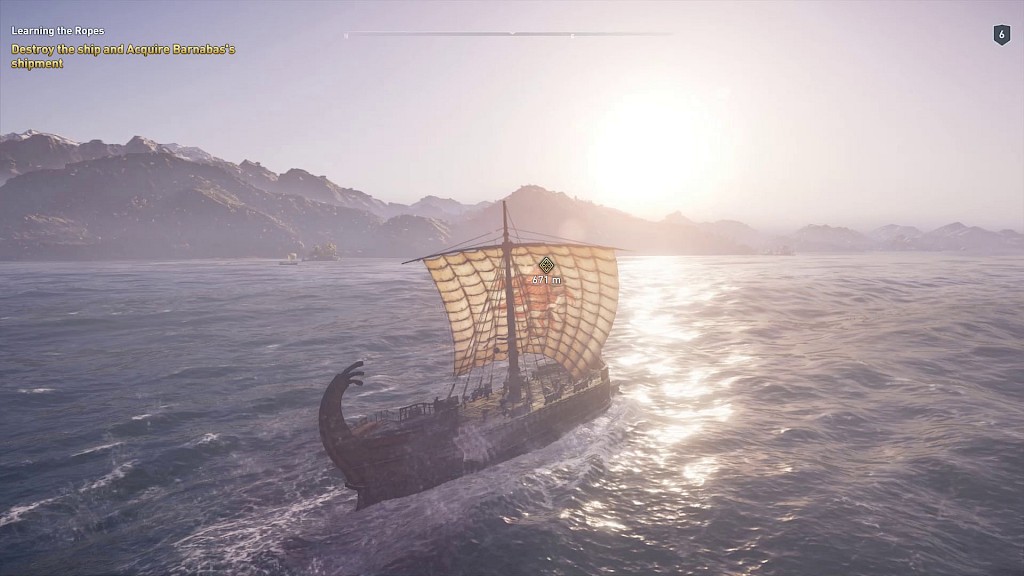
The way that Barnabas worries about going into a “war zone” suggests that there’s been some quite bloody, frequent fighting in the Megarid. In reality, the first half of the Peloponnesian War wasn’t nearly as destructive as the second half would be, and it seems unlikely that the average Greek would have had much to fear from venturing to Megara in 431 BC. But this is a game: if the area around Megara was calm, there wouldn’t be much for the player to do there, nor much risk involved in going there.
Barnabas’ ship is called the Adrestia, which is a Latinized version of ancient Greek Adrêsteia. The name has roughly the meaning of “disinclined to run away”, “inescapable”. In Greek mythology, Adrestia is the daughter of Aphrodite and Ares, and she accompanies her father into battle. She is often associated with Nemesis, the goddess of vengeful retribution. Adrestia is sometimes used as an epithet of Nemesis instead, or simply another name to denote the better known goddess.
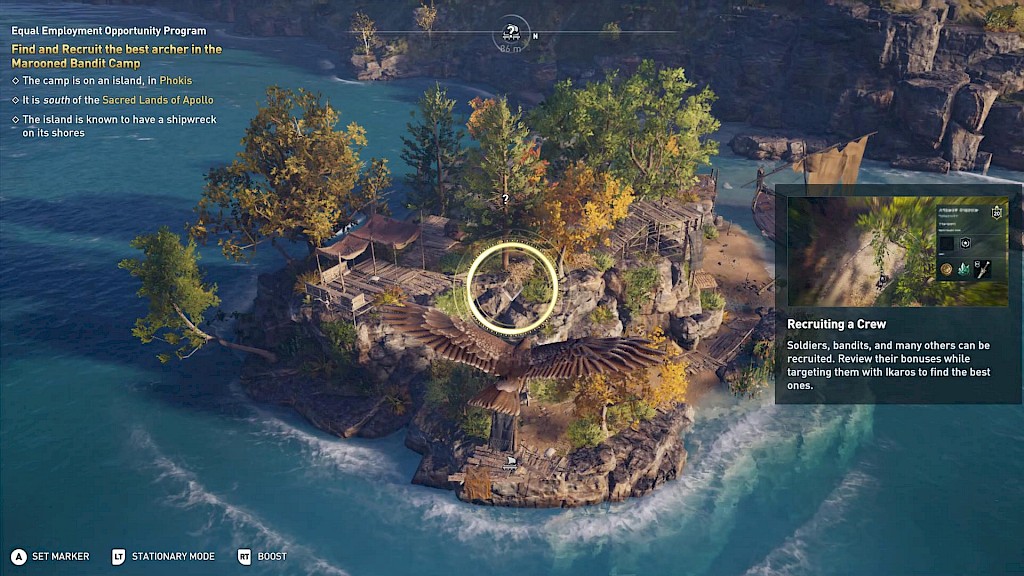
The ship is clearly modelled after a trireme, the typical warship of the age, but the oars seem to be arranged along just a single tier rather than three. Triremes weren’t also actually privately owned back then, but belonged to the state: it’s not very feasible to privately own and operate a ship with 200 crew and almost no space for cargo! (Again, thanks to Roel Konijnendijk for adding some detail here.)
The Adrestia also seems larger and bulkier than a trireme ought to be. We know quite a bit about ancient triremes as they’ve been the subject of intensive research. A full-scale replica of a trireme, the Olympias, exists and is currently part of the Hellenic navy. This vessel also has a fully closed deck, which is actually a bit of a point of contention in scholarly debates.
Triremes were dragged up onto land when not in use. In the Piraeus, the ancient harbour of Athens, ship sheds have been unearthed that were used to house triremes, stern first, and keep them dry. These sheds are approximately 40m in length and just 6m wide. Triremes must have been smaller to fit inside, or about 37m in length and 5m wide. In the game, the Adrasteia seems larger than this, which isn’t too surprising, as games usually have architecture and vehicles larger than normal to make them more easily navigable by players.
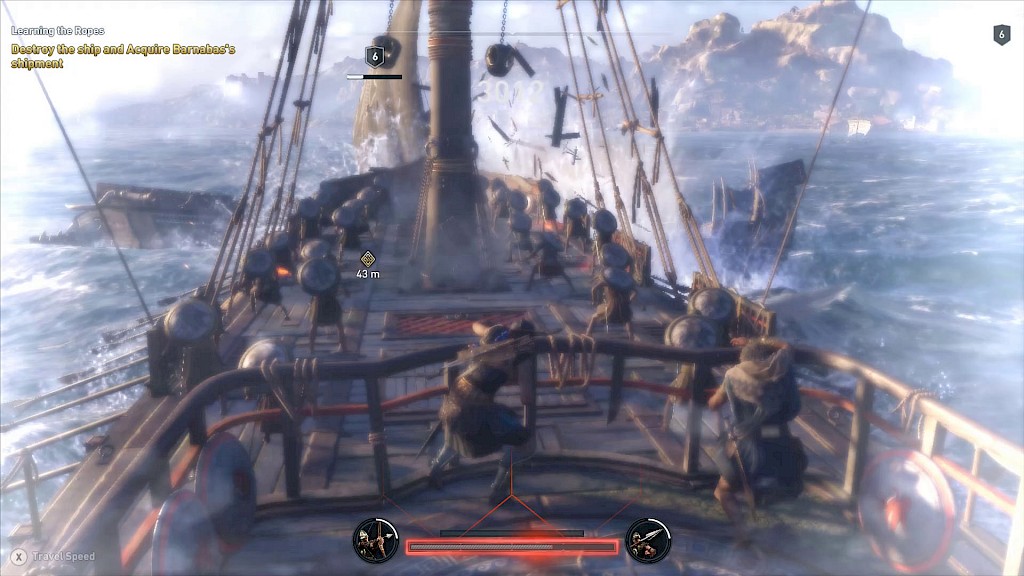
In the game, the ship is also able to get up to speed very quickly, and is incredibly manoeuvrable. Of course, the developers have simplified things here; modelling the movement of a warship accurately would probably not have been as fun or as simple. The developers do deserve some credit in allowing the player multiple modes of attack: ramming, shooting missiles, and boarding are all methods of attack at sea attested in our sources.
Arrival at Megara
After a relatively short trip across the sea, including some naval battles against pirates and Athenian warships, we arrive at the shores of the Megarid. There’s a Spartan camp near where we dock, which features a rather robust wooden palisade. In reality, most camps were rather more flimsy in nature, but I’ll go into further detail about that in a future article.
Instead, I head further inland to the nearby city of Megara (which, as pointed out earlier, the game insists on calling “Megaris”). Megara is located on the Isthmus, the narrow strip of land that connects the Peloponnese to the rest of Greece, and was a major city in Greece throughout the Archaic and Classical periods.
One of my tasks in Megara is to kill the Athenian “soldiers” in the city. Soldier is an interesting word: it ultimately derives from the medieval Latin word soldarius, meaning someone who fights for pay, especially a mercenary. Soldier is typically used for professional fighters, and here it seems out of place: these Athenians are apparently not mercenaries, and they were likely not paid either. It’s one of the reasons why I usually avoid use of the word “soldier” and instead use “warrior” or equivalent terms.
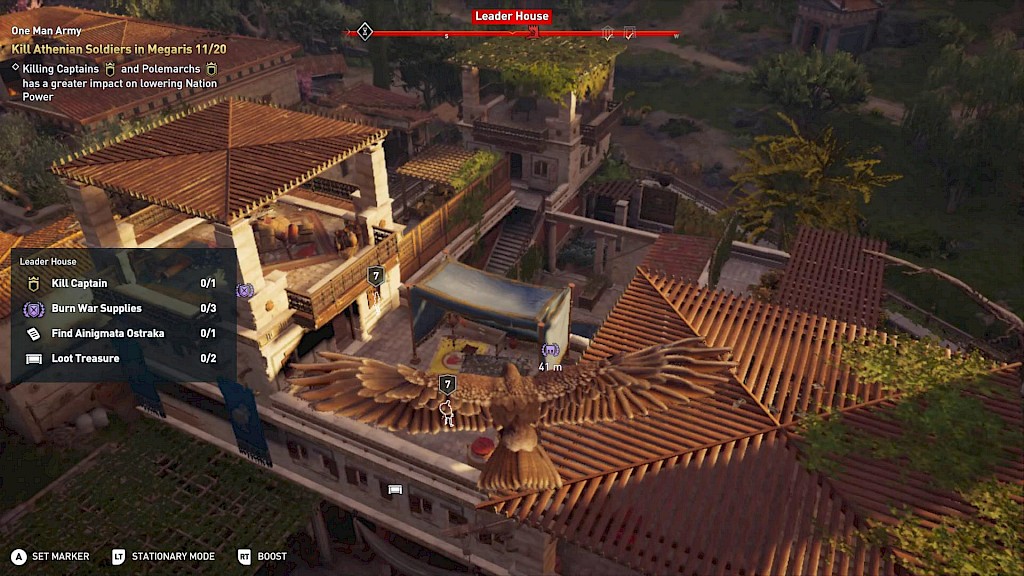
In 431 BC, the year that the game is set, Megara was a staunch ally of Sparta, i.e. a member of the Peloponnesian League (Thuc. 2.9.2). According to Thucydides, the Athenians invaded in the summer of 431 BC, “with their whole levy, resident aliens included, under the command of Pericles.” This was, as Thucydides puts it, “without doubt the largest army of the Athenians ever assmbled” (Thuc. 2.31). But they didn’t occupy Megara: they ravaged the countryside and retreated. Over the course of the remainder of the war, Athens would invade the Megarid every year, until finally they captured Nisaea in 424 BC.
Until then, the Athenians didn’t have a permanent presence in the Megarid. It’s possible that the developers were confused here with the First Peloponnesian War. One hotspot for Athenian activity in the game is the fortified Port of Nisaia. During the First Peloponnesian War, Megara had switched sides for a while and joined the Athenians. The latter had fortified Nisaea (the Latinized version of Nisaia) in 457-456 BC, building “long walls” that connected the port to the city (as per Thuc. 1.103), allowing it to better withstand a siege.
Nisaea in the game looks more like a regular fort, with water on one side and walls protecting it on the other sides. Here, you’re tasked with destroying supplies and assassinating Athenian warriors to further weaken the Athenians’ hold on the region (i.e. their “nation power” in the game’s parlance). Among the leaders that you have to kill, there are officers called polemarchs (i.e. “war-leaders”). Polemarchs – Greek polemarchoi; sing. polemarchos – were officers in command of (part of) an army in various city-states. Among the Athenians, the polemarch was one of the archons or senior magistrates, but in the game commanders of outposts and garrisons are referred to as polemarchs for some reason.
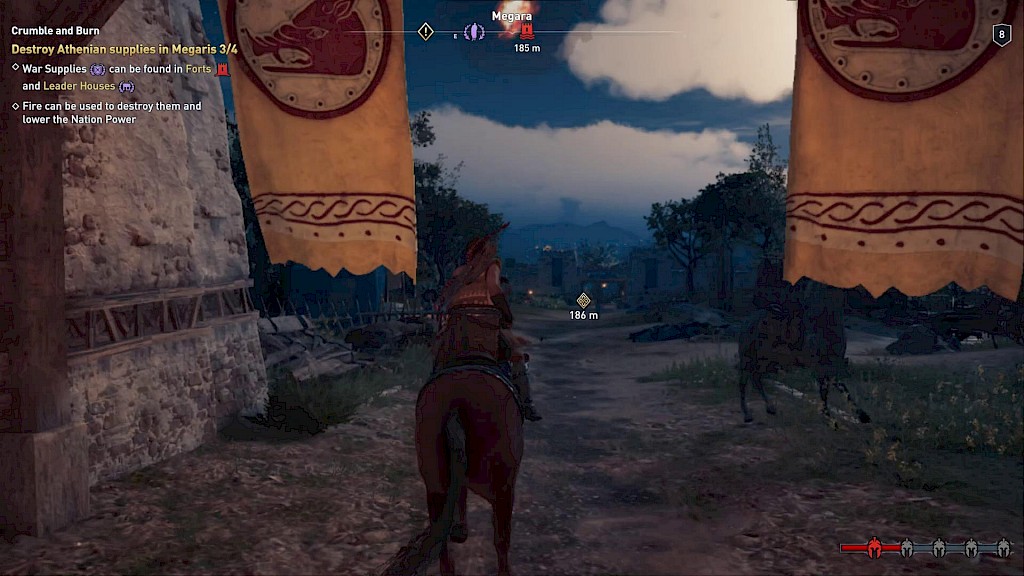
Perhaps this is a good point to make a note of ancient Greek dialects. There were a number of major dialects: the Athenians, for example, spoke a variation of Ionic Greek referred to as Attic, while the Spartans, Megarans, and most other people on the Peloponnese spoke Doric Greek. The Greeks themselves believed that all dialects ultimately derived from three main ones: Doric, Ionic, and Aeolic. Ancient authors seldom comment on differences in dialect, and they were all able to understand each other perfectly (see William F. Wyatt, “Dialects and ethnic groups in Thucydides”, in Robert B. Strassler (ed.), The Landmark Thucydides (1996), pp. 614-616).
Megara itself is the first proper city in the game; it makes the game’s version of Sami on Cephalonia seem like little more than a large village. The city is also fortified with a relatively low wall, perhaps around 5 metres high, with towers flanking the gates. The dimensions seem about what one would expect. The walls are perhaps a bit thicker than they should be, but don’t strike me as implausible.
Incidentally, archaeological and literary evidence has demonstrated that most cities and towns in ancient Greece were fortified, especially in the Classical period. For a comprehensive overview, check out Mogens Hansen and Thomas Nielsen (eds.), An Inventory of Archaic and Classical Poleis (2004), especially pp. 1368-1375, which features an overview of Greek cities and details regarding when they were fortified, and which parts of the town were fortified.
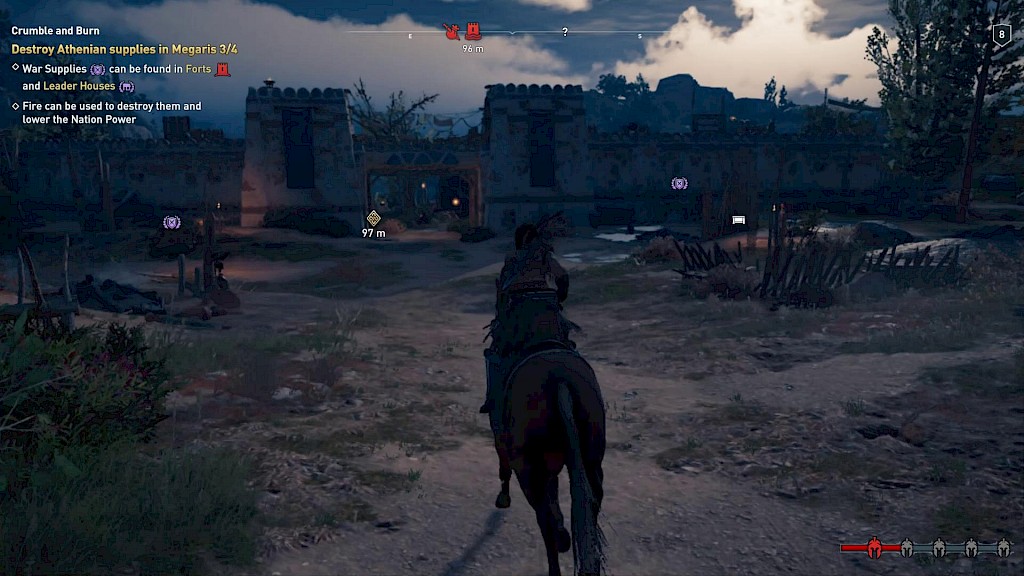
In the game, Megara also features a large temple of Apollo with a tiled roof; again, the colours make it look alive, and seem authentic even if there are details one might quibble about. According to Pausanias, the temple in Apollo in Megara was made of brick, and replaced by a marble temple only during the Roman era (1.42.5). In the game, it seems to be made of marble, but perhaps this is meant to be a different temple.
Time to go
There’s plenty more to write about concerning my adventures in Megara, but I don’t want these articles to go on for too long, or deal with too many topics at once. So next week, I’ll deal more in particular with how I dealt with the Athenian forces in the Megarid, my encounters with the Spartan troops here, the devastation (somehow) wrought by the war, and various other aspects.
However, you’ll have something to look forward to tomorrow, as well. I’ve gone through the game and collected all of the hints that are shown during the loading screens and which have a historical flavour. Some of the information they present is correct, some is incorrect or, at worst, incomplete. I have what I hope is a complete list that I’ll go through one by one, so if you like these articles, rest assured you’re getting more Assassin’s Creed: Odyssey soon.
If you have any specific questions or comments, don’t hesitate to get in touch. And if you like this article and want to see more, please consider supporting Ancient World Magazine on Patreon. Thank you.
